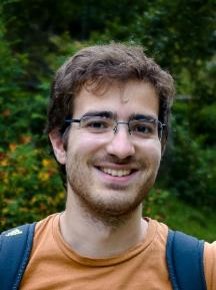
Research Lines
TRACKED
- Tracking site-specific electron transfer dynamics in donor-acceptor dyads using complementary ultrafast.
RELEVANT PUBLICATIONS
Burgos-Caminal et al. Hot Carrier Mobility Dynamics Unravel Competing Sub-ps Cooling Processes in Lead Halide Perovskites. J. Phys. Chem C. 125, 1, 98-106 (2021). https://doi.org/10.1021/acs.jpcc.0c08492
Burgos-Caminal, E. Socie, M. E. F. Bouduban and J.-E. Moser. Exciton and Carrier Dynamics in Two-Dimensional Perovskites. J. Phys. Chem. Lett. 11, 18, 7692−7701 (2020). https://doi.org/10.1021/acs.jpclett.0c0242
W. Yan, A. Burgos-Caminal, T. Das Gupta, J.-E. Moser and F. Sorin. Direct Synthesis of Selenium Nanowire Mesh on a Solid Substrate and Insights into Ultrafast Photocarrier Dynamics. J. Phys. Chem. C 122, 43, 25134–25141 (2018). https://doi.org/10.1021/acs.jpcc.8b08942
Dr. Andrés Burgos is a physical chemist specialized in ultrafast spectroscopy. His main research interests lie in the study of relevant materials for solar energy harvesting and optoelectronic applications. These include new semiconductor thin films, nanostructures, and photocatalytic molecules for artificial photosynthesis. To this end, he employs multiple ultrafast spectroscopy techniques, including time-resolved THz spectroscopy (TRTS), transient absorption spectroscopy (TAS), fluorescence up-conversion spectroscopy (FLUPS), and, more recently, time-resolved X-ray absorption and emission spectroscopies. During his PhD Andrés built an ultrabroadband TRTS setup, which he then used to carry out his research, demonstrating his technical capabilities alongside his scientific ones.
MEET DR. ANDRÉS BURGOS
Dr. Andrés Burgos’s IDEAL project at IMDEA Nanociencia revolves around the study of photoinduced electron transfer dynamics in donor-acceptor dyads. These systems can be applied to different fields that require charge transfer processes, such as photovoltaics and artificial photosynthesis by photocatalysis. Although ultrafast dynamics in these systems is usually studied with optical laboratory techniques, he plans to combine them with the newly available XFEL facilities. Thanks to the sensitivity of X-ray techniques to changes in the oxidation state of different elements with the molecule, they can directly follow the charge transfer process with a specificity that is not possible with laboratory-based optical techniques.
He discovered the IDEAL Fellowship Programme through his supervisor. Dr Andrés Burgos applied for a postdoc at IMDEA Nanociencia for several reasons. He considers it to be a prestigious and well-resourced institution, which has received distinctions such as the Severo Ochoa Centre of Excellence programme. Also, for him, one of the important parts of working at IMDEA Nanociencia is the ease of communication and collaboration between the research groups working both at the institute and associated with it. Between the resources available at the institute and those of the collaborators, it is easy to fulfil most of the experimental parts of the project. He also thinks that the incorporation of a professional development plan for the postdoc has a positive impact on his career, setting goals and helping me to achieve them.
INTERVIEW
What does your research consist of in a broad sense?
My research consists on the use of novel X-ray techniques with femtosecond time-resolution carried out at the large scale facilities called XFELs (X-ray Free Electron Lasers) and other sources.
We want to demonstrate a new way of observing charge transfer in organic donor-acceptor dyads by looking at the oxidation state of specific heteroatoms at different sides of the molecule. I also work on studying charge carrier dynamics in quantum dots from a new perspective thanks to these X-ray facilities.
What would you highlight from your experience in the laboratory?
If there is one thing I would like to highlight it is my participation in beamtimes at different XFELs. These are short periods of a few days where we carry out all our planned experiments in the most efficient way possible. It can be a somewhat exhausting experience, with very long shifts, often overnight, but it is also a moment where you challenge yourself to carry out as much work as possible in the given time: preparing samples, writing specific code to treat and visualize data, etc. In the end, it is a very fulfilling experience where you can learn and obtain a lot of data in a limited amount of time.
How was your experience at IMDEA Nanociencia?
It was a good experience. IMDEA Nanociencia is a place where I can easily collaborate with other researchers in new projects and where I can find a lot of equipment for my research because it can be easily shared.
How has your participation in IDEAL postdoctoral programme benefited your career?
It has benefited it in several ways. I have been able to carry out my research, including the different beamtimes with ease, thanks to the available budget. I have also been able to improve my knowledge in different areas through different training activities and certified courses. Furthermore, I was able to carry out a longer stay at the Linac Coherent Light Source (the American XFEL), participating in different experiments and preparing my own, which was quite successful. Last, it has also permitted that I improve my teaching skills through student supervision and a collaboration with Universidad Autónoma de Madrid to teach several courses.
How do you see the future of nanoscience globally?
Nanoscience is already related to many research topics of interest, and this will only increase in the future. We will see that a large part of the breakthroughs in many fields such as biomedicine, energy conversion and storage, optoelectronics, informatics, etc, will be related in one way or another to nanoscience.
What direction will your career take after your time as an IDEAL fellow at IMDEA Nanociencia?
The future of a career in science is always difficult to predict. However, I plan to continue in the field, hopefully with some sort of tenure-track position in the not so distant future.
More information on the IDEAL Fellowships Programme https://idealcofund-project.eu/postdoc/
The IDEAL Fellowships Programme is supported by the Marie Skłodowska-Curie Actions (MSCA) COFUND. Grant agreement ID: 101034431.
